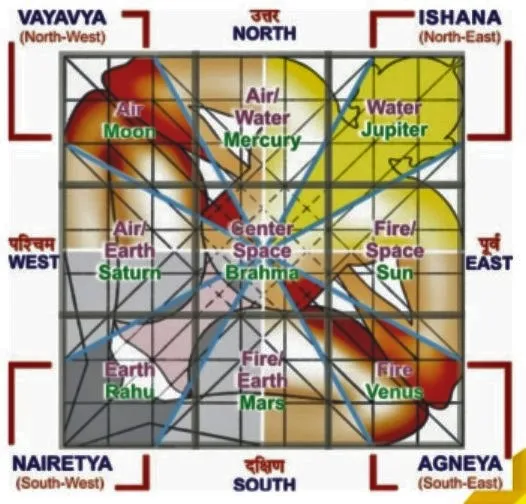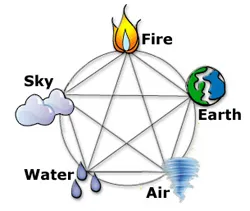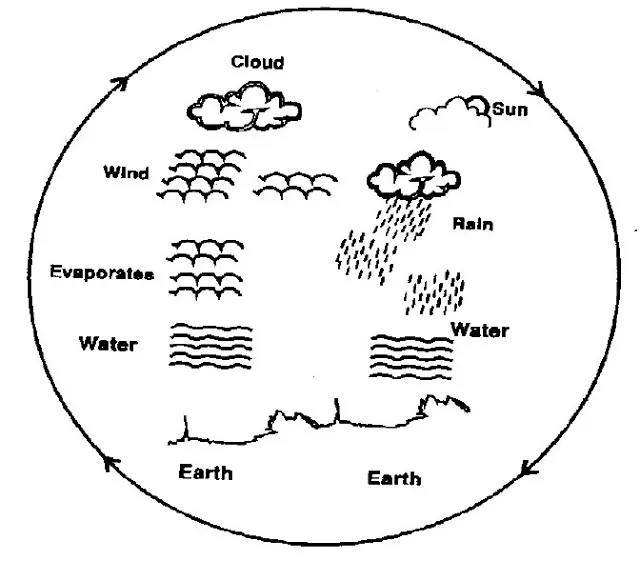If you want to know about the vastu for internal planning of house or vastu for shop or vastu for factory, please click the link.
Vastu Shastra is an ancient Indian system of architecture and design, which is based on the laws of nature and the cosmic principles of energy and balance.

It is said to bring positive energy, harmony, and prosperity to the buildings and spaces where it is practiced. Vastu Shastra originated in India and has been used for thousands of years to design homes, temples, and public spaces in a way that aligns with the natural forces of the universe.
- Vaastu – Shastra is a Vast and ancient science of living. The word Vaastu is derived from the root “Vas” which means “to reside”.
- It is not an equivalent of the word architecture. Vaastu is architecture and much more.
- While architecture is the science, art or profession of designing and constructing buildings etc., the definition of Vaastu extend into the realm of occultism.
- Vaastu Shastra, the edifice science of Bhawan Sthapatya Kala, being the applied aspects of ATHARVAVEDA, is an ancient science and one of the eminent features of our heritage.
- Vaastu means dwelling of Humans and Gods in the original Sanskrit literature.
- Building a house in ancient India was not only a housecraft but also a sacred ceremony and the house was considered a living organism.
- The spirit of the house was called the Vaastu Purusha, and different cardinal directions and sectors were assigned to different Gods like Brahma, Ishwara, Agni, Varun, Wind, Yam and Demon, since the waves flowing in a particular direction have a specific influence.
- Eeshan or north-east is presided over by God and is therefore suitable for a prayer room. The southeast belongs to Agni. The central space is Brahma’s and should be left open to the heavens. The head and limbs of the Vaastu Purusha are to be left alone too.
This is the Introduction of Vastu

1) Basic principles of vastu

- Since the whole universe is a composition of five basic elements: Fire, Air, Space, Earth and Water.
- Through these, our body receives Internal Energies in the form of Proteins, Carbohydrates, Fats etc. and External Energies in the form of Heat, Light, Sound, Wind and so on.
- The basic principles of Vaastu enables us to achieve balance among these; giving more flexibility of body & mind for a better life.
- When the harmony between these elements gets disturbed, our energies get dissipated in different directions leading to stress, tension and ill health and our peace of mind is destroyed.
- We then have to redirect our Energies subjectively as well objectively, so as to achieve an equilibrium between Internal / External Energies, to attain a healthy body and a happy mind leading to health, wealth, happiness, prosperity and success.
- The natural cycle of the elements is given here under.

- The water from the Earth evaporates into the atmosphere (Space) due to the heat in our Solar System (Sun).
- These droplets of water accumulate to form clouds.
- The Air which moves the clouds makes them release the excess water which comes back to the Earth in the form of Rain.
- Thus, the Cycle, as well as the equilibrium of the elements, is maintained on our planet. To experience the above cycle you need a mind and to have a mind you need life. Therefore the 5 elements.
- The above Energy Cycle is radiation energies corresponding to an element such as:

- This is this placement of universal elements in relation to the four principal directions:

For better results, any activity in your residence or office should be supplemented by the cosmic position of the elements.
- The North-East (NE) is assigned to Water: Have a bore well, underground water tank in that position.
- The South-East (SE) is assigned to Fire: Have your kitchen, pantry, furnace, boiler there.
- The North-West (NW) is assigned to Air: There have a guestroom bedroom for unmarried girls or a store for finished goods.
- The South-West (SW) is assigned to Earth: It is the most stable of all elements. Keep it heavy and this is the best place for master Bedroom.
- The Centre is assigned to Space: Have the least possible activity in this area.
2) The birth of vastu purusha
- Vaastu Purush is present in each and every plot whether it is big or small.
- He has a fixed and peculiar body.
- His head remains hanging down and his body is spread all over the length and breadth of the ground.
- There is an interesting story in the MATSYA PURAN in which the birth of Vaastu Purusha is narrated.
- By reading that story one knows why the worship of the Vaastu Purusha is necessary before beginning construction of any building.
- Long long ago Lord Shiva fought against the demon named ANDHAKA and killed him.
- While fighting with demon, Shiva was very much tired and began to sweat profusely.
- A man was born of the drops of Shiva’s sweat.
- He looked very cruel.
- He was very hungry.
- So, he began to make penance to appease Lord Shiva and get a boon from him.
- Shiva was pleased with his penance and appeared before him.
- The devotee prayed to Shiva,” Oh Lord! Please permit me to eat away all the three worlds.” Shiva said,” Let it be so.” The devotee’s joy knew no bounds.
- He got possession on all the three worlds and first he was ready to eat the terrestrial world (Bhooloka).
- Then the celestial (Devatas), Brahma, Shiva and the demons (Rakshasas) also were terrified and caught hold of the devotee encircling him.
- Vaastu Purusha, being arrested like this, said to the Gods, “Oh, Celestial Beings! You have all caught hold of me and tied me on all the sides.
- How long shall I be like this, in this position hanging my head down like a prisoner? What shall I eat? Listening to those words, the celestial beings said, “Today is Bhadrapada Shukla Triteya Saturday and ‘Visakha Star’; So, you lie down here on the ground changing your position once in three months, i.e., from ‘Bhadraspada’ to ‘kartik’ you lie down putting your head in the eastern direction and your feet towards the west.
- During the months of “Margashira”, ‘Pusham’ and ‘Magha’, you lie down towards the south looking towards the west and put your feet towards the north during the months of ‘Phalgun’, ‘Chaitra’ and ‘Vaisakh’ put your head towards the west and feet towards the east., looking towards the north; in the months of ‘Jyestha’, ‘Ashadha’ and ‘Sravana’, put your head towards the east.
- North and the feet towards the south & look towards the east.
- Whatever side you may turn, you will have to lie down on the left side only.
- You will be known as ‘VAASTU PURUSHA’.
- You will tease the people, to your heart’s content, who construct buildings and temples, dig wells and tanks on the side towards which you see and in the direction towards which you hold your feet.
- You may trouble and even devour those people who construct the aforesaid buildings and temples etc. In the direction where you lay your head and back and those who lay foundation-stone without worshipping you or without satisfying you with “Homa” and the like.
- Then the Vaastu-Purusha was quite satisfied. Since then, the worship of Vaastu-Purusha has been in vogue, and it has become compulsory for those who want to construct any kind of building.

3) The Five Main Elements
All objects of this universe are made of five elements basically. These five basic elements are
- Earth or Soil
- Water
- Fire
- Air
- Space (Aakash).
- These are called “Panch Mahabhoot”.
i) Earth
- Earth here means composition of the surface of the Earth, the soil and other minerals present in the soil.
- The upper part of the surface is called soil, Stone, sand, iron, lime etc., all these are parts of soil.
- All these physical elements are available in limited quantity and on a particular place.
- This depends on the composition of surface, its form and size, trees and vegetation grown upon it etc. that whether it will be appropriate to inhabit at such a place or not. Moreover, if there is a residence there, what type of construction should be there.
- Availability of essential building materials and their transportation also depend upon the formation of soil.
- Soil can be categorized on the basis of its shape, touch, taste and sound.
- We must take care that it suits our physique while selecting land for building and collecting building material.
- There are many things described in Vaastu Shastra about the size and type of land and method of “Bhoomi Poojan” are also explained in it.
ii) Water
- It is most essential for all creatures and is a basic element in construction. Water forms 3/4 part of body’s weight.
- All of us know about different forms and resources of water.
- The quantity of water available at present is limited and is less than the requirement.
- Not only for creatures and vegetation but also for house construction, water is needed in sufficient quantity.
- Therefore, it should be ensured before house construction, whether water will remain available or not.
- Usually, in most of the villages a pond is available along with ground water source, which is maintained by villagers themselves.
- People inhabit colonies on the banks of rivers, lakes and sea, where underground water is available in large quantity and wells can be dug up in a suitable place for colonies.
- Shape and size of building and life style are designed at a place according to the availability of water and relation with land.
- Taking care of water also means the house is stable even during heavy rains, the building is not harmed and flood does not cause havoc.
- Taste forms, feeling and sound are characteristics of water.
iii) Fire
- Fire circulates energy in the form of light and heat.
- The sun is the main source of light and heat for us.
- The movement of the earth in relation to the sun causes day and night and change in seasons.
- Rain and wind are also possible due to the heat of the sun. The sun provides living beings with courage, zeal and power.
- Most of the colonies in the world are found in temperate zones where Sun’s energy is available in sufficient quantity.
- Care should be taken that the building has constant supply of light, it is completely safe from fire, construction material is selected in such a way that it is fit for living comfortably in both seasons – in summer as well as in winter and it is not destroyed by lightning. Thus, house construction plan is greatly affected by heat and light (i.e., Fire). Shape , feeling and sound are characteristics of fire .
iv) Air
- Atmosphere (i.e. mixture of gases like Oxygen , Nitrogen, Carbon dioxide, Ozone etc.) exists around the earth up to 400 km height approximately.
- Composition of atmosphere and presence of vapours in it differ from place to place according to local situations.
- We cannot see air but we can feel and hear it. Air is an essential element for all living beings.
- It is essential to have correct supply, correct temperature and pressure, correct percentage of humidity in the air for both kinds of comforts- physical and mental for man.
- Therefore, the shape, size, construction and direction of buildings should be such as they have sufficient supply of air for healthy and comfortable living.
- No part of the building should remain without air.
- Foul air should not gather in the building and fresh air should come continuously.
- From which direction air should enter or not is also important. In our country the air blowing from the South is considered baneful and inauspicious.
v) Space
- Space is the most widely spread over of the five basic elements. The unending region of the universe in which all the heavenly bodies exist is called space (Aakaash).
- There is no place in the universe where this space does not exist. Gravitational pull of various heavenly bodies, magnetic power, different kinds of radiations and waves like ultra -violet rays, infra- red rays, light rays, cosmic rays, etc. are always present in space. Their effects can be felt in many forms, and many activities and designs (plans) in our life are conducted by their effects.
- Sound is produced in space only.
- If there is no space, sound waves are not possible.
- The form in which space permits the building will decide accordingly the form of our talking, singing and playing, weeping and other activities.
- The echo of our sound will go according to space.
- Therefore, the houses should be built in such a way and plan that these invisible forces of nature and the energies generated by them can be fully utilized and their harmful effects can be avoided.
- Human body is also made of five basic elements and similarly all the other things of the world are made of them.
- Therefore, the five basic elements existing inside, and outside man have a constant though invisible relation which affects activities of life. In our residence or office buildings, etc., are constructed in a well- planned manner keeping in view the effects of “Panchmahabhoot”, i.e., the five basic elements – earth, water, air, space and fire- life can be full of more happiness and prosperity.
- The ancient Rishis and Sages had knowledge of the relation between five basic elements and their energies and their utility in needed quantity.
- Therefore, Vaastu shastra explains such principles of house building according to which appropriate use of the effects of these five basic elements can be achieved by selecting land accordingly, as soil inhabits our body, similarly our body inhabits a building.
- The effects of these five basic elements have been fully taken care of in the principles laid down in Vaastu Shastra, by which a residence can be made for a comfortable life and not merely for show.
In conclusion, Vastu Shastra is a rich and complex tradition that has been practiced in India for thousands of years. While some may view it as superstition, others believe in its benefits and continue to use its principles in their homes and places of work. Whether or not you believe in its principles, there’s no denying that the principles of Vastu Shastra can lead to the creation of beautiful and harmonious spaces.
[…] concept of Vastu Shastra revolves around the idea of aligning the built environment with the cosmic energies and […]